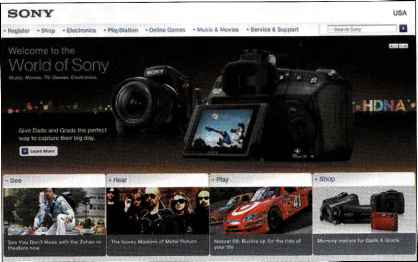Product Mix Decisions
An organization with several product lines has a product mix, A product mix (or product portfolio) consists of all the product lines and items that a particular seller offers for sale. Some companies manage very complex product portfolios. AFor example, Sony's diverse portfolio consists of four primary product businesses worldwide: Sony Electronics, Sony Computer Entertainment (games), Sony Pictures Entertainment (movies, TV shows, music, DVDs), and Sony Financial Services (life insurance, banking, and other offerings).
Each major Sony business consists of several product lines. For example, Sony Electronics includes cameras and camcorders, computers, TV and home entertainment products, mobile electronics, and others. In turn, each of these lines contains many individual items. Sony's TV and home entertainment line includes TVs, DVD players, home audio components, digital home products, and more. Altogether, Sony's product mix includes a diverse collection of hundreds and hundreds of products.
A company's product mix has four important dimensions: width, length, depth, and consistency. Product mix width refers to the number of different product lines the company carries. Sony markets a wide range of consumer and industrial products around the world, from TVs and PlayStation consoles to semiconductors. Product mix length refers to the total number of items the company carries within its product lines. Sony typically carries many products within each line. The camera and camcorder line, for instance, includes digital cameras, camcorders, photo printers, memory media, and tons of accessories.
Product mix depth refers to the number of versions offered of each product in the line. Sony has a very deep product mix. For example, it makes and markets about any kind of TV you'd ever want to buy—tube, flat panel, rear projection, front projection, HD or low resolution—each in almost any imaginable size. Finally, the consistency of the product mix refers to how closely related the various product lines are in end use, production requirements, distribution channels, or some other way. Within each major business, Sony's product lines are fairly consistent in that they perform similar functions for buyers and go through the same distribution channels. Companywide, however, Sony markets a very diverse mix of products. Managing such a broad and diverse product portfolio requires much skill.
These product mix dimensions provide the handles for defining the company's product strategy. The company can increase its business in four ways. It can add new product lines, widening its product mix. In this way, its new lines build on the company's reputation in its other lines. The company can lengthen its existing product lines to become a more full-line company. Or it can add more versions of each product and thus deepen its product mix. Finally, the company can pursue more product line consistency—or less—depending on whether it wants to have a strong reputation in a single field or in several fields.

- Product mix decisions: Sony has a large and diverse product portfolio, divided into four primary product businesses, each containing hundreds of products. "Welcome to the world of Sony."
Author I a brand represents Comment | everything that a product or service means to consumers. As such, brands are valuable assets to a company. For example, when you hear someone say "Coca-Cola," what do you think, feel, or remember? What about "Harley-Davidson"? Or "Google"?
Branding Strategy: Building Strong Brands (pp 259-268)
Some analysts see brands as the major enduring asset of a company, outlasting the company's specific products and facilities. John Stewart, former CEO of Quaker Oats, once said, "If this business were split up, I would give you the land and bricks and mortar, and I would keep the brands and trademarks, and I would fare better than you." A former CEO of McDonald's declared, "If every asset we own, every building, and every piece of equipment were destroyed in a terrible natural disaster, we would be able to borrow all the money to replace it very quickly because of the value of our brand. . . . The brand is more valuable than the totality of all these assets."18
Thus, brands are powerful assets that must be carefully developed and managed. In this section, we examine the key strategies for building and managing brands.

Consumers sometimes bond very closely with specific brands. Jokes the bride at this wedding: "He loves DeWalt nearly as much as he loves me."
Brand equity
The differential effect that knowing the brand name has on customer response to the product or its marketing.
Continue reading here: Building Strong Brands
Was this article helpful?
Readers' Questions
-
robert1 year ago
- Reply
-
crescente1 year ago
- Reply
-
SUSAN1 year ago
- Reply
-
gustavo1 year ago
- Reply
-
Selassie Semere1 year ago
- Reply
-
mellisa busby1 year ago
- Reply
-
Ines1 year ago
- Reply